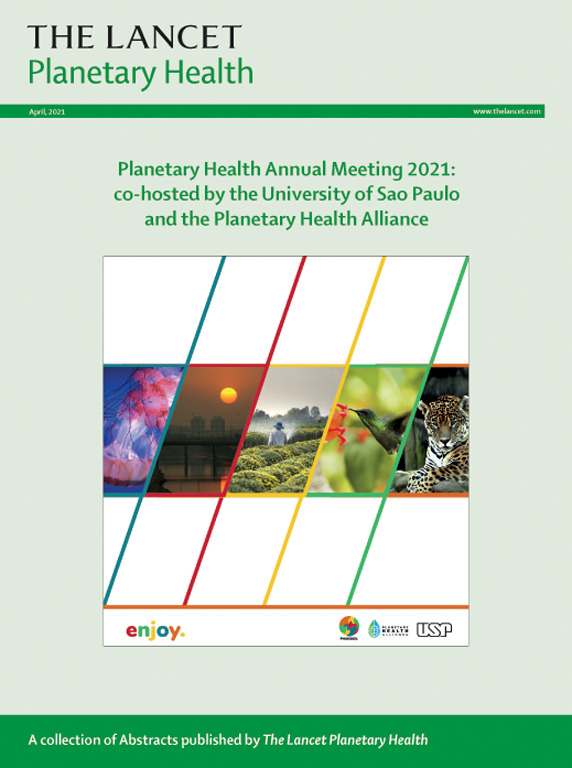National and provincial burden of disease attributable to fine particulate matter air pollution in China, 1990–2021: an analysis of data from the Global Burden of Disease Study 2021
IF 24.1
1区 医学
Q1 ENVIRONMENTAL SCIENCES
引用次数: 0
Abstract
Background
Fine particulate matter (PM2·5) is the leading environmental risk factor for mortality and disability worldwide. We aimed to evaluate the temporal trend in, and spatial distribution of, the disease burden attributable to PM2·5 in China from 1990 to 2021.
Methods
Based on the methodology framework and general analytical strategies applied in the Global Burden of Diseases, Injuries, and Risk Factors Study 2021, we calculated the numbers, age-standardised rates, and percentage of deaths and disability-adjusted life-years (DALYs) attributable to PM2·5 air pollution from 1990 to 2021 at the national and provincial level in China, by disease, sex, and age groups. Exposure to PM2·5, including ambient PM2·5 pollution and household PM2·5 pollution from solid fuels, was evaluated across 33 provincial administrative units in China.
Findings
In 2021, 2·3 million (95% uncertainty interval [UI] 1·8–2·9) deaths and 46·7 million (36·6–59·7) DALYs could be attributable to PM2·5 pollution in China, accounting for 19·4% (16·0–23·6) of total deaths and 11·6% (9·4–14·1) of total DALYs. Of these, 1·9 million (95% UI 1·3–2·3) deaths and 37·8 million (26·3–46·5) DALYs resulted from ambient exposure, while 0·4 million (0·1–1·3) deaths and 8·9 million (1·5–27·8) DALYs were due to household exposure from solid fuel use. Stroke, ischaemic heart disease, and chronic obstructive pulmonary disease were the leading three causes. Two peaks in the burden were observed: in children aged younger than 5 years, and in people aged 70 years and older. The percentage of deaths and DALYs due to ambient PM2·5 was higher in men, while that due to household PM2·5 was higher in women. Geographically, the disease burden from ambient PM2·5 was higher in north and northwest China, while that from household PM2·5 was higher in southwest China. From 1990 to 2021, age-standardised death rates attributable to total PM2·5 decreased by 66·0% (95% UI 57·7–73·1) and those attributable to household PM2·5 decreased by 92·2% (76·6–98·7), with larger reductions observed in east and south China. By contrast, the disease burden related to ambient PM2·5 continued to increase and only began to decline in the past decade.
Interpretation
Despite the decline in the disease burden attributable to total PM2·5 in China during 1990–2021, ambient PM2·5 remains a major contributor to mortality and disability. This study highlights considerable spatial heterogeneity across different provinces and provides valuable insights for developing geographically tailored strategies for PM2·5 control and public health promotion in China. Stricter control of ambient air pollution is needed in northern and northwestern regions, while promoting clean cooking energy is more urgently warranted in southwestern areas.
Funding
National Natural Science Foundation of China, National Key Research and Development Program of China, Shanghai Municipal Science and Technology Major Project, China Postdoctoral Science Foundation.
1990-2021年中国细颗粒物空气污染导致的国家和省级疾病负担:对2021年全球疾病负担研究数据的分析
细颗粒物(PM2·5)是世界范围内导致死亡和残疾的主要环境风险因素。我们旨在评估1990 - 2021年中国PM2·5致病负担的时空变化趋势和空间分布。方法基于《2021年全球疾病、伤害和风险因素负担研究》中应用的方法框架和一般分析策略,我们按疾病、性别和年龄组计算了1990年至2021年中国国家和省级PM2·5空气污染导致的死亡和伤残调整生命年(DALYs)的数量、年龄标准化率以及百分比。对中国33个省级行政单位的PM2·5暴露进行了评估,包括环境PM2·5污染和固体燃料产生的家庭PM2·5污染。研究发现,2021年,中国可归因于pm2.5污染的死亡人数为230万(95%不确定区间[UI] 1.8 ~ 2.9), DALYs为4670万(36.6 ~ 59.7),占总死亡人数的19.4%(16.0 ~ 23.6),占总DALYs的11.6%(9.4 ~ 14.1)。其中,环境暴露导致190万例(95% UI为1.3 - 3.2)死亡和3780万例(263 - 46.5)DALYs,而家庭固体燃料使用暴露导致340万例(1.1 - 3.1)死亡和890万例(1.5 - 27.8)DALYs。中风、缺血性心脏病和慢性阻塞性肺病是导致死亡的前三大原因。在5岁以下的儿童和70岁及以上的老年人中观察到两个负担高峰。男性因环境PM2·5导致的死亡和伤残残疾率较高,而女性因家庭PM2·5导致的死亡和伤残残疾率较高。从地理上看,华北和西北地区环境PM2·5的疾病负担较高,而西南地区家庭PM2·5的疾病负担较高。从1990年到2021年,归因于总pmm2·5的年龄标准化死亡率下降了66.0% (95% UI为57.7 - 73.1),归因于家庭pmm2·5的年龄标准化死亡率下降了92.2%(76.6 - 98.7),中国东部和南部降幅较大。相比之下,与环境PM2·5相关的疾病负担在过去十年中持续增加,仅开始下降。尽管1990-2021年间中国总pm2.5导致的疾病负担有所下降,但环境pm2.5仍然是导致死亡和残疾的主要因素。该研究突出了不同省份间的空间异质性,为制定中国PM2·5控制和公共健康促进的地理策略提供了有价值的见解。北方和西北地区需要更严格地控制环境空气污染,而西南地区则更迫切需要推广清洁烹饪能源。国家自然科学基金,国家重点研究发展计划,上海市科技重大专项,中国博士后科学基金。
本文章由计算机程序翻译,如有差异,请以英文原文为准。
求助全文
约1分钟内获得全文
求助全文
来源期刊

Lancet Planetary Health
Multiple-
CiteScore
28.40
自引率
2.30%
发文量
272
审稿时长
8 weeks
期刊介绍:
The Lancet Planetary Health is a gold Open Access journal dedicated to investigating and addressing the multifaceted determinants of healthy human civilizations and their impact on natural systems. Positioned as a key player in sustainable development, the journal covers a broad, interdisciplinary scope, encompassing areas such as poverty, nutrition, gender equity, water and sanitation, energy, economic growth, industrialization, inequality, urbanization, human consumption and production, climate change, ocean health, land use, peace, and justice.
With a commitment to publishing high-quality research, comment, and correspondence, it aims to be the leading journal for sustainable development in the face of unprecedented dangers and threats.
 求助内容:
求助内容: 应助结果提醒方式:
应助结果提醒方式:


